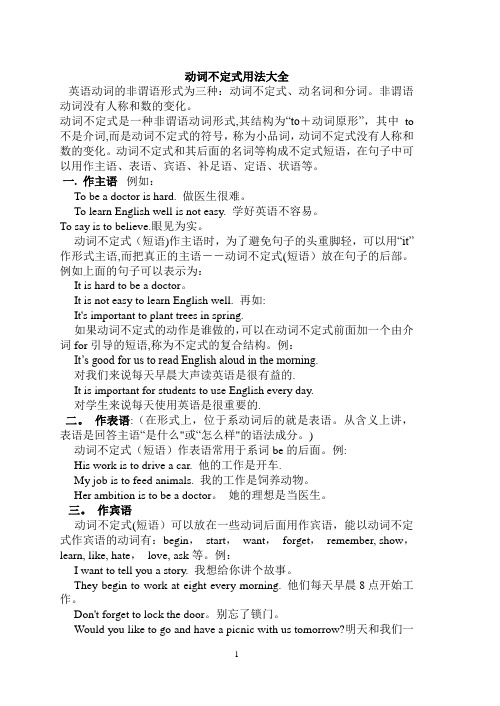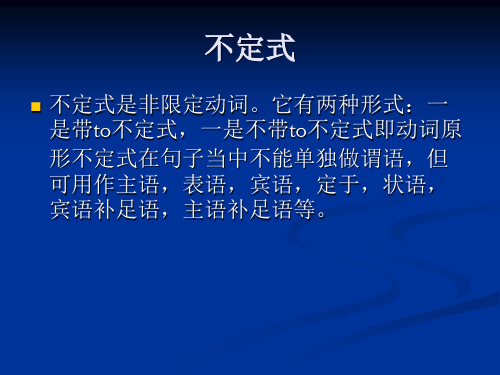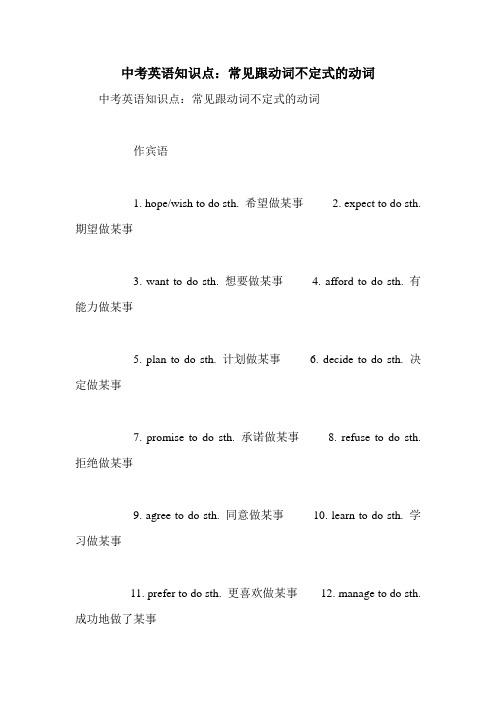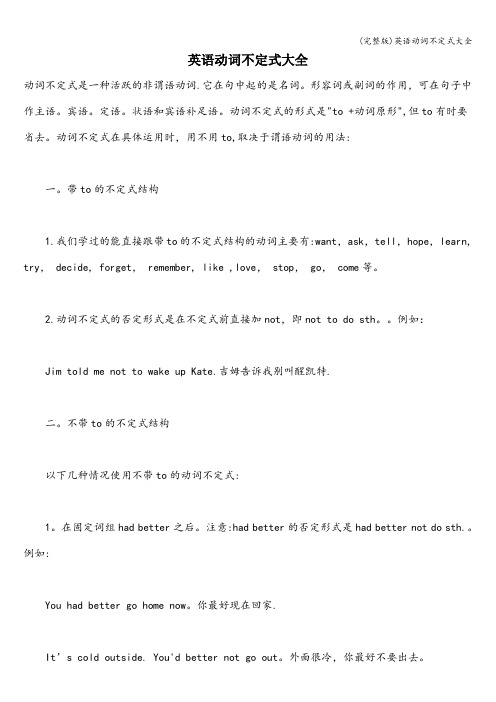英语动词不定式大全
动词不定式用法大全

动词不定式用法大全英语动词的非谓语形式为三种:动词不定式、动名词和分词。
非谓语动词没有人称和数的变化。
动词不定式是一种非谓语动词形式,其结构为“to+动词原形”,其中to 不是介词,而是动词不定式的符号,称为小品词,动词不定式没有人称和数的变化。
动词不定式和其后面的名词等构成不定式短语,在句子中可以用作主语、表语、宾语、补足语、定语、状语等。
一. 作主语例如:To be a doctor is hard. 做医生很难。
To learn English well is not easy. 学好英语不容易。
To say is to believe.眼见为实。
动词不定式(短语)作主语时,为了避免句子的头重脚轻,可以用“it”作形式主语,而把真正的主语--动词不定式(短语)放在句子的后部。
例如上面的句子可以表示为:It is hard to be a doctor。
It is not easy to learn English well. 再如:It's important to plant trees in spring.如果动词不定式的动作是谁做的,可以在动词不定式前面加一个由介词for引导的短语,称为不定式的复合结构。
例:It’s good for us to read English aloud in the morning.对我们来说每天早晨大声读英语是很有益的.It is important for students to use English every day.对学生来说每天使用英语是很重要的.二。
作表语:(在形式上,位于系动词后的就是表语。
从含义上讲,表语是回答主语“是什么"或“怎么样"的语法成分。
)动词不定式(短语)作表语常用于系词be的后面。
例:His work is to drive a car. 他的工作是开车.My job is to feed animals. 我的工作是饲养动物。
高中英语动词不定式(共26张PPT)

Because of the recent accident, our parents forbid my brother and me from swimming in the river unless someone agrees to watch over us.
Her husband can do everything except cook.
He wanted nothing but to stay there. 注意:如果but 或except 之前有实义动词do 的限定性
是或非限定形式,其宾语为不带to的不定式,否则为 带to的不定式。 Lots of empty bottles were found under the old man’s bed. He must have done nothing but ____ (drink) I thought you had planned to pradcrtiincekpiano today. “I did nothing but___ letters all day.”
careless,,clever,good,foolish,honest,kind,lazy,nice,right,silly, stupid,wise,等表示赞扬或批评的形容词,不定式前的 sb.可作其逻辑主语。
It is better to die on one’s feet than ____
A. to write B. write C. writing D. wrote
5、不定式(短语)做宾语补足语
在复合宾语中,动词不定式可充当宾语补 足语,如下动词常跟这种复合宾语:want, wish, ask, tell, order, beg, permit, help, advise, expect, encourage, persuade, allow, prepare, cause, force, call on, wait for, invite.,observe, intend, press, remind warn, lead, command 等, 如:
英语动词不定式的用法

英语动词不定式的用法英语动词不定式的用法在英语中,动词不定式是一种独立的动词形式,由动词原形前加上“to”构成。
它可以作为名词、形容词或副词使用,具有丰富的用法。
以下是一些常见的动词不定式用法:1. 作主语•To learn a foreign language is beneficial to one’s career development. 学一门外语对职业发展有益。
•To eat a balanced diet is essential for good health. 保持均衡的饮食对健康至关重要。
2. 作宾语•I want to travel around the world. 我想环游世界。
•She enjoys singing and dancing. 她喜欢唱歌和跳舞。
3. 作表语•Her dream is to become a successful entrepreneur. 她的梦想是成为一名成功的企业家。
•The most important thing is to never give up. 最重要的事情是永不放弃。
4. 作定语•We need a qualified teacher to teach advancedmathematics. 我们需要一位合格的教师教授高级数学。
•He had no money to buy a new car. 他没有钱买一辆新车。
5. 作状语•She worked hard to pass the exam. 她为了通过考试而努力学习。
•He took a taxi to catch the train. 他打车去赶火车。
6. 作补语•Our goal is to win the championship. 我们的目标是赢得冠军。
•She was happy to see her parents again. 她见到父母很高兴。
中考英语知识点:常见跟动词不定式的动词

中考英语知识点:常见跟动词不定式的动词中考英语知识点:常见跟动词不定式的动词作宾语1. hope/wish to do sth. 希望做某事2. expect to do sth. 期望做某事3. want to do sth. 想要做某事4. afford to do sth. 有能力做某事5. plan to do sth. 计划做某事6. decide to do sth. 决定做某事7. promise to do sth. 承诺做某事8. refuse to do sth. 拒绝做某事9. agree to do sth. 同意做某事10. learn to do sth. 学习做某事11. prefer to do sth. 更喜欢做某事12. manage to do sth. 成功地做了某事13. fail to do sth. 未能做某事14. offer to do sth. 主动提出做某事15. choose to do sth. 选择做某事作宾语补足语1. want sb. to do sth. 想要某人做某事2. teach sb. to do sth. 教某人做某事3. tell sb. to do sth. 告诉某人做某事4. invite sb. to do sth. 邀请某人做某事5. warn sb. to do sth. 警告某人做某事6. ask sb. to do sth. 要求某人做某事7. allow sb. to do sth. 允许某人做某事8. advise sb. to do sth. 建议某人做某事9. expect sb. to do sth. 期望某人做某事10. remind sb. to do sth. 提醒某人做某事11. order sb. to do sth. 命令某人做某事12. encourage sb. to do sth. 鼓励某人做某事13. force sb. to do sth. 强迫某人做某事。
动词不定式用法大全

动词不定式用法大全英语动词的非谓语形式为三种:动词不定式、动名词和分词。
非谓语动词没有人称和数的变化。
动词不定式是一种非谓语动词形式,其结构为“to+动词原形”,其中to 不是介词,而是动词不定式的符号,称为小品词,动词不定式没有人称和数的变化。
动词不定式和其后面的名词等构成不定式短语,在句子中可以用作主语、表语、宾语、补足语、定语、状语等。
一. 作主语例如:To be a doctor is hard. 做医生很难。
To learn English well is not easy. 学好英语不容易。
To say is to believe.眼见为实。
动词不定式(短语)作主语时,为了避免句子的头重脚轻,可以用“it”作形式主语,而把真正的主语--动词不定式(短语)放在句子的后部。
例如上面的句子可以表示为:It is hard to be a doctor.It is not easy to learn English well. 再如:It’s important to plant trees in spring.如果动词不定式的动作是谁做的,可以在动词不定式前面加一个由介词for引导的短语,称为不定式的复合结构。
例:It’s good for us to read English aloud in the morning.对我们来说每天早晨大声读英语是很有益的。
It is important for students to use English every day.对学生来说每天使用英语是很重要的。
二. 作表语:(在形式上,位于系动词后的就是表语。
从含义上讲,表语是回答主语“是什么”或“怎么样”的语法成分。
)动词不定式(短语)作表语常用于系词be的后面。
例:His work is to drive a car. 他的工作是开车。
My job is to feed animals. 我的工作是饲养动物。
英语不带to的动词不定式归纳

不带to的动词不定式的十八种情况动词不定式通常带有符号to,叫做带to的动词不定式(infinitive with"to"),动词不定式有时不带符号to,叫做不带to的动词不定式(infinitive without"to")不带to的动词不定式通常有下面十八种情况一、与助动词do连用构成谓语动词的否定、疑问和强调形式。
(1)he does not work in the factory.(2)Does she work here?(3)I did not see her yesterday.(4)Did they take you home?(5)He does look tired.(6)They did come yesterday.二、与情态动词连用构成复合谓语(1)I can speak English.(2)May I come in?(3)Dare he swim across the river?(4)We must work,and above all we must believe in ourselves.(5)Could you do something for me?(6)You shall go at once.(7)He might be working in the office now.(8)I don't think you need have come yesterday.(9)They should be here by now.(10)If you will go into the fields and turn over a few big stones,you are sure to uncover a city of ant"people".但与情态动词ought(to)连用时通常带to,和used(to)连用时必须带to三、在表示感觉的动词如:see,look.at,watch,hear,listento,feel,notice,observe,perceive(觉察,看见),behold(书面用语“见到”)等后用作宾语补足语的动词不定。
初中英语中的动词不定式

初中英语中的动词不定式动词不定式作在句中可以充当主语、宾语、宾语补足语、目的状语等。
1.动词不定式作宾语当句了中已经有谓语动词,而我们又要表达不止一个动作概念时,其它的动词可以使用非谓语形式表达。
动词不定式就是动词的种非谓语形式,其基本形式是“to + 动词原形”。
如:He wants to play football after class,他想课后瑞足球.Remember to turn off the light when you leave the romm. 记住离开房间时把关灯了。
注意:动词不定式在句子中不作谓语,因此没有人称、数和时态的变化。
动词不定式在句中常作谓语动词的宾语,这一类谓语动词常见的有:agree(同意),choose(选择),decide(决定),forget(忘记),hope(希望),learn(学习),ike(喜欢),plan(计划),prepare(准备),promise(答应),refuse(拒绝),remember(i记得),seem(觉得好像),want(想要),wish(希望),would like(想要)。
我们可以这样来记忆,choose to do something,decide to do something等。
She decided to visit her grandparents this weekend.她决定这个周未去看望她的祖父母。
注意:动词不定式的否定形式是“not to + 动词原形”。
如:You must promise not to be late again.你必须保证不再迟到了。
2.疑问词+ 动词不定式我们可以用“疑问词+ 动词不定式”结构作动词的宾语。
疑问词包括疑问代词wht、which、who和疑问副词how、when、where等。
常和“疑问词+ 动词不定式”结构连用的动词及动词短语有:know、learn、see、hear、ask、tell、advise、decide、explain、find out、forget、remember、think、understand、wonder等。
(完整版)英语动词不定式大全

英语动词不定式大全动词不定式是一种活跃的非谓语动词.它在句中起的是名词。
形容词或副词的作用,可在句子中作主语。
宾语。
定语。
状语和宾语补足语。
动词不定式的形式是"to +动词原形",但to有时要省去。
动词不定式在具体运用时,用不用to,取决于谓语动词的用法:一。
带to的不定式结构1.我们学过的能直接跟带to的不定式结构的动词主要有:want, ask, tell, hope, learn, try, decide, forget, remember, like ,love, stop, go, come等。
2.动词不定式的否定形式是在不定式前直接加not,即not to do sth。
例如:Jim told me not to wake up Kate.吉姆告诉我别叫醒凯特.二。
不带to的不定式结构以下几种情况使用不带to的动词不定式:1。
在固定词组had better之后。
注意:had better的否定形式是had better not do sth.。
例如:You had better go home now。
你最好现在回家.It’s cold outside. You'd better not go out。
外面很冷,你最好不要出去。
2.在let,make,see, feel, watch,hear等感官或使役动词后,要跟不带to的动词不定式作宾语补足语.例如:I made them give me the money back.我迫使他们把钱还给我。
I didn't see you come in.我没看见你进来.3.在引导疑问句的why not之后。
"Why not+不带to的不定式"是Why don't you do…的省略,可以用来提出建议或劝告。
例如:Why not go with us。
为什么不和我们一起去呢。
Why not take a holiday。
- 1、下载文档前请自行甄别文档内容的完整性,平台不提供额外的编辑、内容补充、找答案等附加服务。
- 2、"仅部分预览"的文档,不可在线预览部分如存在完整性等问题,可反馈申请退款(可完整预览的文档不适用该条件!)。
- 3、如文档侵犯您的权益,请联系客服反馈,我们会尽快为您处理(人工客服工作时间:9:00-18:30)。
英语动词不定式大全动词不定式是一种活跃的非谓语动词。
它在句中起的是名词。
形容词或副词的作用,可在句子中作主语。
宾语。
定语。
状语和宾语补足语。
动词不定式的形式是"to +动词原形",但to有时要省去。
动词不定式在具体运用时,用不用to,取决于谓语动词的用法:一。
带to的不定式结构1.我们学过的能直接跟带to的不定式结构的动词主要有:want, ask, tell, hope, learn, try, decide, forget, remember, like ,love, stop, go, come 等。
2.动词不定式的否定形式是在不定式前直接加not,即not to do sth.。
例如:Jim told me not to wake up Kate.吉姆告诉我别叫醒凯特。
二。
不带to的不定式结构以下几种情况使用不带to的动词不定式:1.在固定词组had better之后。
注意:had better的否定形式是had better not do sth.。
例如:You had better go home now.你最好现在回家。
It's cold outside. You'd better not go out.外面很冷,你最好不要出去。
2.在let,make,see, feel, watch,hear等感官或使役动词后,要跟不带to 的动词不定式作宾语补足语。
例如:I made them give me the money back.我迫使他们把钱还给我。
I didn't see you come in.我没看见你进来。
3.在引导疑问句的why not之后。
"Why not+不带to的不定式"是Why don't you do…的省略,可以用来提出建议或劝告。
例如:Why not go with us。
为什么不和我们一起去呢。
Why not take a holiday。
=Why don't you take a holiday。
为什么不休个假呢。
三。
动词不定式作主语不定式结构作主语时,现代英语倾向于采用it作形式主语,而把不定式结构后置的形式。
参见本期本面《"小鬼it"它当家》中it作形式主语的用法。
四。
动词不定式作定语不定式作定语,要放在它所修饰的名词或代词的后面。
例如:I have nothing to say on this question.对这个问题我无可奉告。
五。
动词不定式作宾语有的及物动词要求跟复合宾语(即宾语+宾语补足语)。
如果其中的宾语是不定式短语,则必须将形式宾语it放在宾语的位置上,而将不定式短语(真正的宾语)放在宾语补足语之前。
例如:I find it useful to learn English well.我发现学好英语很有用。
We thought it wrong not to tell her.我们认为不告诉她是错误的。
六。
动词不定式作宾语补足语动词不定式作宾语补足语是动词不定式用法的一个重点,学习时要注意以下三种情况:1.作动词ask, like, tell等的宾语补足语时,动词不定式符号to不可以省略。
例如:He asked me to talk about English study.他请我谈谈英语学习。
2.作使役动词let, have, make以及感官动词feel, hear, see, watch等的宾语补足语时,动词不定式符号to要省略。
例如:The teacher made him say the word like this.老师让他像这样说这个单词。
3.作动词help的宾语补足语时,动词不定式符号to可以带,也可以不带。
例如:Could you help me (to) carry the heavy box。
你能帮我搬这个重箱子吗。
七。
动词不定式作状语动词不定式及其短语具有副词的特性,可在句中用作状语。
1.放在句首也可以放在句尾表示目的等。
例如: He stopped to have a rest.他停下来休息。
2.跟在作表语的形容词或过去分词的后面。
例如:I'm sorry to hear that.听到这事我感到很难过。
3.用在too... to...结构中。
例如:He is too young to understand all that.他太年轻了,不能理解这件事有些动词后面跟to do和动词-ing形式所表达的意思不同。
这类动词有:remember,forget,regret, try,mean,go on, stop等。
如:I told him of the matter again,for I forgot having met him after the accident.Don‘t forget to lock the door. It is not safe enough here.① try to do “努力做某事” try doing “尝试做某事”He tried to work out the problem.He tried working out the problem in another way.② mean to do “打算做某事” mean doing “意味着”What! Did you mean to leave by train?Missing the train means waiting for an hour.③ regret to do 因没做某事而遗憾,抱歉 regret doing 因做过某事而遗憾,后悔I regret to say I can‘t help you.I regret saying such silly words.④ go on to do 继续另外一件事 go on doing 继续同一件事⑤stop to do 停下去做另外一件事 stop doing停下正在做的事⑥ preferI prefer reading to going shopping on weekends.I would prefer to spend the weekend at home rather than drive.⑦ allow, advise, forbid, permitSorry, we don’t allow smoking in the lecture room.We don’t allow people to smoke here. I wouldn’t advise taking the car --- there’s nowhere to park.I wouldn’t advise you to take the car.need,want,require,deserveneed to be done= need doing-ing 动词短语的用法一. 动词的-ing 形式作定语:running water running shoes flying fish flying suitliving things living conditions dancing waves a waiting busa waiting room a swimming boy a swimming pool a writing desk China is a developing country.The man talking with our headmaster is Tom’s father.Do you know the three children walking toward us?二. 动词的-ing 形式作宾语补足语动词的-ing 形式可以在某些动词如: see, hear, notice; watch, keep, find, get, have, feel 等词后与一个名词或代词构成复合宾语.1.Suddenly he heard someone knocking gently on the window.2.I’m sorry to have kept you waiting.3.Do you see a girl running towards us?4.I can’t have you catching cold.5.Did you see a strange man ______ (go / going) to the building?三. 动词的-ing 连用的重要句型:1. have difficulty ( trouble, problem, fun, pleasure, a good time , a hard time) (in )dong sth.e.g. We had no difficulty ( problem, trouble) in finding his house.I had a good time living with the neighbour.We had much fun / pleasure talking with him.2. There’s no need / use/ harm / hurry / knowing (in) doing sth.e.g. There’s no use making an excuse for this.There’s no need waiting for him.There’s no hurry getting ready for this.3. feel like doing4. be in the habit of doing sth.5. on doing sth.e.g. On hearing the news, I changed my play. = As soon as I heard the news, I changed my play.6. be worth doing四. 动词的-ing 形式作主语1. Reading aloud is very important in learning a foreign language.2. Studying abroad is very difficult in the first few months.3. Seeing is believing.动词的-ing 形式作主语时常用句型:1.It’s no good / use doing sth.: It’s no good / use having a car if you can’t drive.2.It’s great fun doing sth. It’s great fun ( to prepare ) preparing for a party.3.It’s a waste of time doing sth. It’s a waste of time talking to him.4.It’s interesting / foolish / nice / difficult doing sth.e.g. It’s interesting organizing ( to organize) a dance.5. There is no….e.g. There’s no joking about such matters.There’s no saying what may happen. 无法估计将会发生什么事.五. 动词的-ing 形式作表语1. My hobby is colleting stamps.2. The real problem is getting to know the needs of the students.注: 动词的-ing 形式和不定式都可以作主语或表语, 一般来说, 在表示抽象笼统的一般动作时多用动词的-ing 形式; 在表示具体某次动作,特别是将来的动作时, 多用不定式.如:1.Smoking is not allowed here.2.It isn’t good for you to smoke so much.3.My job is typing letters and papers.4.My job now is to type these letters and papers.六. 动词的-ing 形式作宾语:1. 只接动词的-ing 形式作宾语的动词和动词短语: finish, complete, suggest, avoid, stop, mind,enjoy, delay, practice, advise, consider, escape, miss, imagine, risk, prevent, appreciate, resist, keep on, give up, put off, get through, dislike, can’t help, burst into, succeed in; feel like; be fond of; keep on; stop ( prevent ) … from; be used to doing; spend … on; be interested in2. 两者都可以,但区别较大者:1)remember / forget / regret2)try3)mean4)like / prefer / hate / love (抽象、笼统与具体、特定)e.g. I hate speaking before a big audience. / I hate to say so, but I really ca n’t go.I love doing comedies. / I’d love to go to the cinema now.5)start / begin在以下三种情况下,只用不定式作宾语:a. 主语是物不是人:The weather began / started to get fine.b. start 和begin用于进行时:He’s beginning / starting to cook the dinner.c. 后跟表示情感、意念或思想的动词:I began / started to realize that I was wrong.6)stop 7)go on七.动词的-ing 形式作状语1. Arriving there, he made up his mind t go in.2. Not knowing her telephone number, I couldn’t get in touch with her.3. Helen was sitting by the window, reading a novel.4. His parents died, leaving him a lot of money.当动词的-ing 形式所表示的动作发生在谓语动作之前,应使用完成式,即:having done. 如:1.Having finished homework, he rushed out to play football.2.Having invited him to give us a talk, we’d better go to listen to him.3.Having been ill for a long time, he needed time to recover.动词的-ing 形式还有被动式,表示与句子的主语之间是被动关系。
